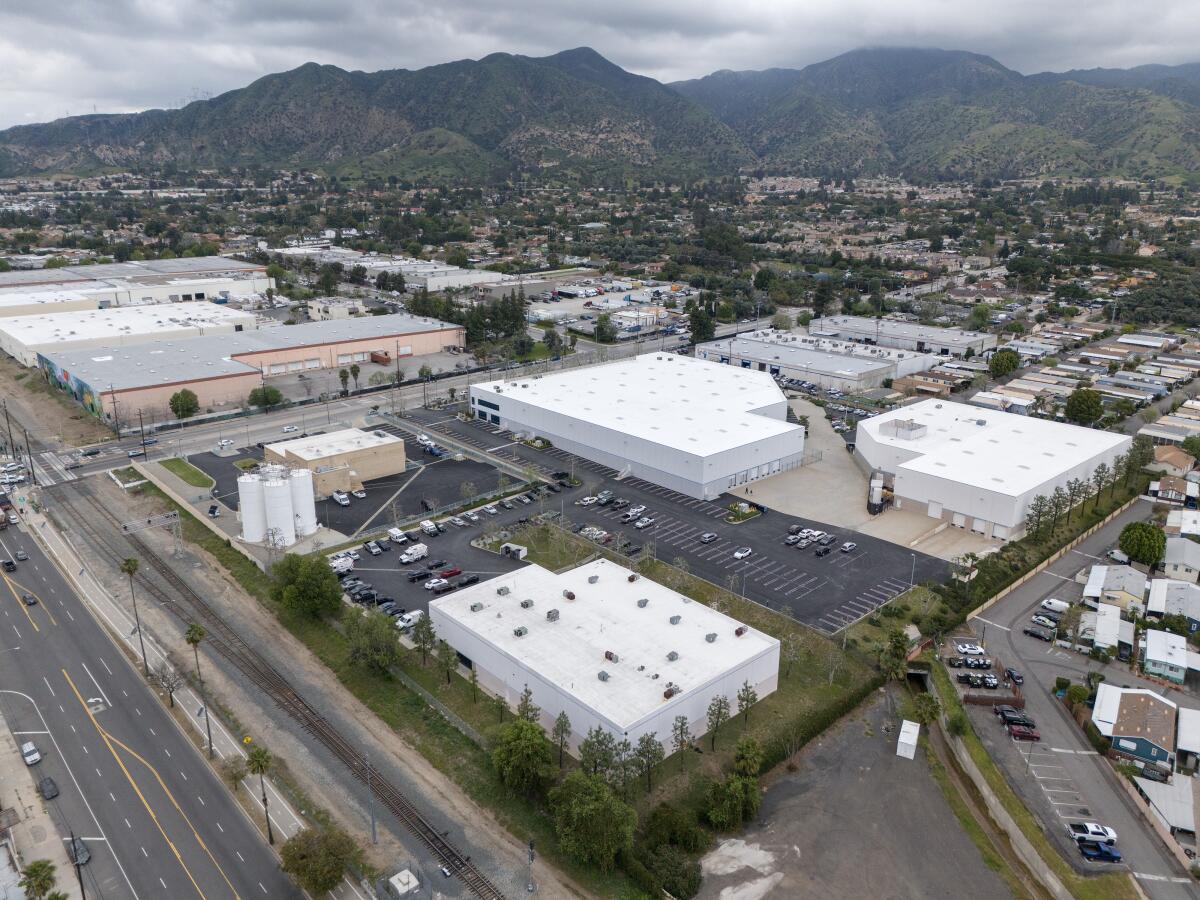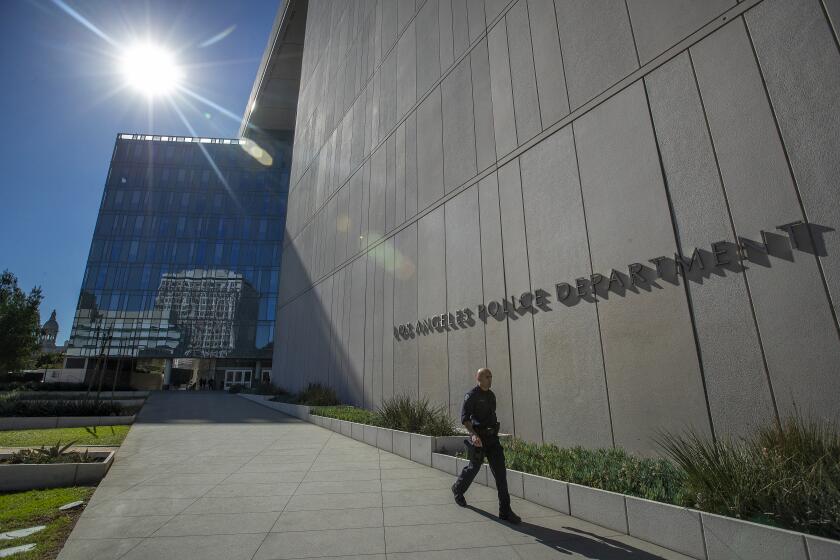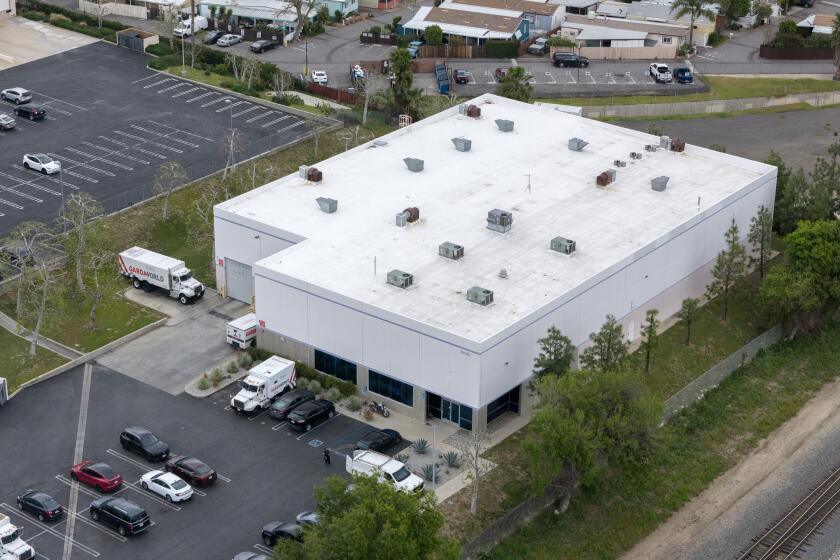Police responded to alarm around time of $30-million L.A. heist, but thieves were undetected

- Share via
The Los Angeles Police Department responded to three separate alarms at GardaWorld’s Sylmar cash storage facility on the day that thieves stole as much $30 million from its vault during the biggest heist in the city’s history.
Despite the officers’ presence at the property in the early hours of Easter Sunday — including around the time it is believed the sophisticated burglary was carried out — the criminals remained undetected, according to three law enforcement officials familiar with the investigation of the incident.
During at least one of the responses by a patrol car, GardaWorld was alerted, according to the officials, but the Montreal-based security services company did not register the intrusion.
The Times has previously reported that GardaWorld did not learn of the crime until opening the vault the following day, April 1. It wasn’t until then, officials said, that LAPD investigators were notified that a substantial amount of money had been taken.
The sequence of events, partly disclosed in an LAPD call-for-service log obtained by The Times, raises questions about the security GardaWorld maintained at the Roxford Street property, which is used to process and store cash for the company’s L.A.-area customers. The timeline also reveals details of the complex crime, which is believed to have been carried out by a crew that breached the one-story building via its roof.
Jeffrey Zwirn, a longtime security consultant, said the success of the heist appeared to be the result of “a systemic failure.”
“The physical and the electronic security appear to have had a deficiency that was either not checked by the alarm company, and/or the security command center and/or the security director designated with making sure the system was more than adequate in light of its high-risk environment,” he said.
GardaWorld did not respond to requests for comment.
Thieves stole as much as $30 million Sunday night at a facility in Sylmar where cash from businesses across the region is handled and stored.
According to the police log, the LAPD responded to 13 alarm calls at the building in the year prior to the heist, and all of them were determined to be false alarms. Notably, one occurred just before 11:30 p.m. on March 30, the night before the heist. A patrol car arrived at the warehouse minutes later and deemed it a false alarm.
Another alarm rang at the building at 4:36 a.m. on Easter, according to the log. Hours later, the log shows, a police car was dispatched to the property, a supervisor was notified and a report was written. The log does not indicate what the police found. However, a resident at the neighboring Tahitian Mobile Home Park previously told The Times that FBI agents visited her the day after the burglary and asked if she “saw or heard anything suspicious around 4 a.m.” on Easter. (The woman said she was asleep at the time and did not.)
At 7.22 a.m., another alarm rang at GardaWorld’s warehouse and a police car responded about 45 minutes later; the LAPD log shows it was considered a “valid alarm.” Finally, an alarm rang at 3:51 p.m. and a police car arrived around 4 p.m. in response. This was deemed a false alarm, according to the log, the details of which were first reported by TMZ.
According to Aria Kozak, chief executive of L.A.-based security services company Elite Interactive Solutions, the false alarms triggered before the heist could have been the result of criminals testing the security apparatus at the building.
“In that particular case, the false alarms could just be a little window into the criminal activity,” he said. “They are very capable and smart and they will look for the soft or weak spot.”
Days after thieves stole as much as $30 million from a security company vault in Sylmar, residents and workers piece together details of the crime.
Law enforcement agencies have remained extraordinarily tight-lipped about the investigation. LAPD Capt. Kelly Muniz declined to discuss the timeline of the crime, explaining that the probe was being handled by the FBI. An FBI spokeswoman said she could not disclose when the agency responded to the heist and declined to provide details of the inquiry.
The burgled GardaWorld facility, hemmed in by active train tracks and the mobile home park on two sides, is situated in a scruffy section of Sylmar where locals have said that street crime is a scourge. And neighbors have said that strange things occurred in the area over the weekend.
A park resident has said that she heard a strange mechanical sound coming from the GardaWorld property over Easter weekend. Her home offers a view of a portion of the warehouse where thieves also breached the side of the building. A KABC-TV News video aired April 3 showed a large cut on the side of the structure that was covered by a piece of plywood. And the owner of a nearby convenience store said its Wi-Fi was down much of Easter and mobile phone calls failed, too. It’s unclear whether that was connected to the heist, but Wi-Fi jammers have become a common tool of theft gangs because they knock out many security cameras.
Given the amount of money stored at the Roxford Street facility, such anomalous activity should have been detected by GardaWorld or an alarm service provider, according to security industry experts.
Starting last summer, a string of heists carried out by masked men on local freeways has upended L.A.’s jewelry business, with tens of thousands of dollars taken in odd crimes.
Security consultant Jim McGuffey, who previously held senior positions at Brink’s and Loomis, called the heist “a very professional job.” Nonetheless, he said, “there is no way this should have happened.”
“A well-protected facility that houses that kind of money ... normally in those facilities they have two separate alarm systems, they have sensors throughout the facility, cameras on the inside and outside,” he said. “No matter how you penetrate the building, a sensor detects that activity and sends an alert. That’s why it was such a shock.”
Zwirn added that such a property would typically include an alarm system that would be triggered by the presence of wireless signal jamming.
“While these perpetrators were sophisticated ... based on what we know, this should have been a detectable event,” he said. “The question is why no one responded to what should have been a detectable event.”
More to Read
Sign up for Essential California
The most important California stories and recommendations in your inbox every morning.
You may occasionally receive promotional content from the Los Angeles Times.















